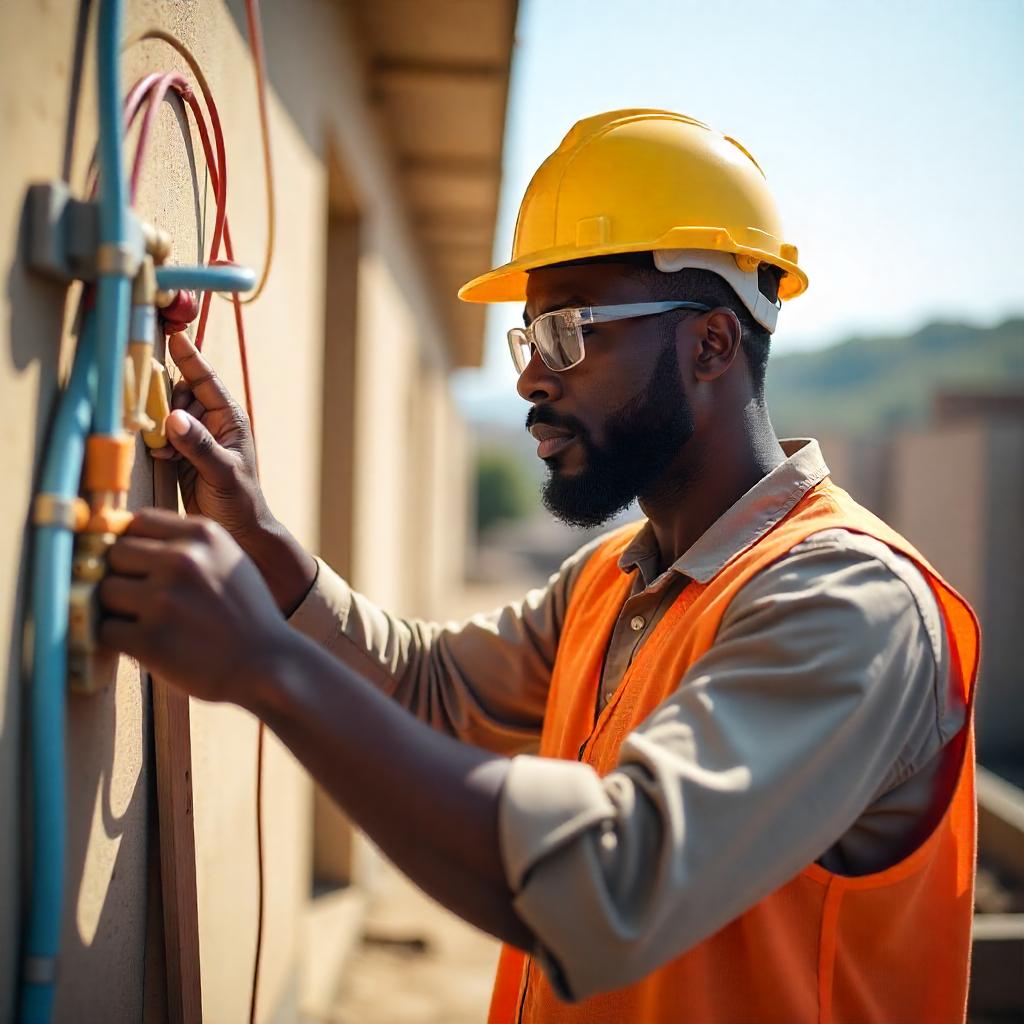
Electrical hazards are among the most serious dangers on construction sites. Workers face risks such as electric shocks, arc flashes, burns, fires, and even electrocution. The combination of high-voltage equipment, temporary wiring setups, and the often unpredictable conditions of construction environments means that electrical safety must be a top priority for every site manager and worker.
This detailed guide covers critical aspects of electrical safety on construction sites, including common hazards, prevention strategies, equipment requirements, and best practices for creating a safer workplace.
Understanding Electrical Hazards on Construction Sites
Electrical hazards occur when workers come into contact with energized parts or equipment in unsafe ways. Unlike other construction hazards, electricity can cause instantaneous injury or death and often leaves lasting physical and psychological effects on survivors.
The main sources of electrical hazards in construction include:
-
Contact with overhead power lines: Construction equipment such as cranes, scaffolds, and ladders may inadvertently come too close or touch overhead lines, causing severe electrical shocks or fatal injuries.
-
Damaged electrical tools and cords: Repeated use, harsh environments, and improper storage can degrade electrical tools and cords. Exposed wiring or broken insulation increases the risk of shocks.
-
Temporary wiring and installations: Construction sites frequently require temporary electrical power with extension cords, generators, and makeshift circuits. Improper installation or overloading can cause faults and fires.
-
Lack of grounding and bonding: Ungrounded tools or equipment can energize metal parts, leading to accidental contact with live electricity.
-
Wet or damp working conditions: Water is an excellent conductor of electricity. Working in rainy weather or wet surfaces multiplies the risk of electrical injuries.
-
Improper lockout and tagout: Failure to disconnect power and secure circuits during repairs or maintenance can cause unexpected energization of electrical systems, endangering workers.
The Importance of Risk Assessment and Planning
A thorough risk assessment is the foundation of any effective electrical safety program. It involves identifying potential electrical hazards, assessing their likelihood and severity, and determining necessary control measures.
Key components of a solid risk assessment include:
-
Mapping all electrical sources and equipment on site
-
Identifying tasks involving exposure to energized parts
-
Recognizing environmental factors such as weather and ground conditions
-
Evaluating the competency of personnel performing electrical work
-
Reviewing historical incidents and near misses for lessons learned
Following the risk assessment, site managers should develop and implement detailed safety plans and procedures tailored to the specific electrical risks present on their construction sites.
Training and Competency: Preparing the Workforce
Electrical safety training is not a one-time event but an ongoing process. All workers should receive basic awareness training about electrical hazards, even if they are not directly involved with electrical work.
For personnel assigned to electrical tasks, specialized training must cover:
-
Safe handling of electrical tools and equipment
-
Correct procedures for connecting and disconnecting power
-
Identification and use of protective devices such as circuit breakers and ground fault interrupters
-
Proper lockout and tagout techniques to ensure isolation of power
-
Emergency procedures for electrical injuries and fires
Regular refresher training sessions help maintain awareness and keep safety knowledge current with evolving regulations and technologies.
Use and Maintenance of Electrical Equipment
Electrical equipment on construction sites includes hand tools, power tools, extension cords, generators, lighting, and temporary power distribution systems. Proper use and maintenance are crucial to prevent electrical incidents.
Best practices include:
-
Inspect all cords, plugs, and tools daily before use for signs of damage or wear
-
Avoid using electrical equipment with frayed cords, cracked insulation, or exposed wires
-
Use ground fault circuit interrupters for all temporary power sources to quickly cut power in case of faults
-
Ensure all equipment is properly grounded to prevent buildup of stray electrical currents
-
Store electrical equipment in dry, secure locations when not in use to prevent damage and contamination
Personal Protective Equipment for Electrical Work
Personal protective equipment (PPE) serves as the last line of defense against electrical hazards. Depending on the task and risk level, workers should be equipped with:
-
Insulated gloves tested for electrical resistance
-
Electrical rated boots to prevent current flow through the body
-
Flame resistant clothing to protect against arc flash burns
-
Safety goggles or face shields to shield eyes from sparks or debris
-
Hard hats rated for electrical hazards
Regular inspection and proper cleaning of PPE are essential to maintain their protective properties.
Safe Work Practices and Procedures
Implementing standardized safe work procedures is essential for controlling electrical risks. These procedures include:
-
Always assuming that electrical circuits are energized until proven otherwise
-
Testing circuits for voltage with appropriate instruments before starting work
-
De-energizing electrical equipment whenever possible before performing maintenance or repairs
-
Applying lockout and tagout systems to isolate electrical sources and prevent accidental energization
-
Maintaining safe working distances from overhead lines and electrical panels
-
Avoiding the use of metal ladders or conductive tools near live electrical parts
-
Prohibiting the use of electrical equipment in wet or damp conditions without proper protection
Additionally, all temporary electrical installations must be clearly marked, secured against unauthorized access, and regularly inspected.
Managing Electrical Installations on Construction Sites
Construction sites often involve complex temporary electrical systems to power tools, lighting, and machinery. Effective management includes:
-
Ensuring temporary wiring is installed by qualified personnel following accepted electrical codes and practices
-
Using cables and connectors rated for outdoor or rugged use
-
Preventing overloading by calculating loads accurately and distributing circuits evenly
-
Protecting cables from physical damage by routing them away from high-traffic areas or using protective covers
-
Clearly identifying and labeling all circuits and disconnects for quick identification during emergencies
Emergency Preparedness and Response
Despite all precautions, electrical accidents can still occur. It is essential that all workers know how to respond swiftly and safely:
-
Never touch a person who is still in contact with a live electrical source; first disconnect the power
-
Call for medical help immediately and begin cardiopulmonary resuscitation if trained and necessary
-
Use appropriate fire extinguishers for electrical fires, such as carbon dioxide or dry chemical types—water should never be used on energized electrical equipment
-
Report all electrical incidents and near misses promptly to facilitate investigations and prevent recurrences
Cultivating a Culture of Electrical Safety
Beyond rules and equipment, fostering a culture that values electrical safety can transform the work environment. This involves:
-
Encouraging workers to identify hazards and speak up about unsafe conditions without fear of retaliation
-
Leading by example, with supervisors and managers consistently following safety practices
-
Incorporating electrical safety into daily toolbox talks and safety meetings
-
Recognizing and rewarding safe behaviors and proactive hazard mitigation
-
Continuously reviewing and improving safety policies based on feedback and incident analysis
Conclusion
Electrical safety in construction is an ongoing commitment that requires diligence, knowledge, and teamwork. By understanding hazards, assessing risks, training workers, maintaining equipment, enforcing safe procedures, and fostering a safety culture, construction sites can dramatically reduce electrical accidents and protect their most valuable asset: their people.
Prioritizing electrical safety is essential not only for regulatory compliance but also for the well-being and productivity of everyone on site. The success of any construction project depends on a foundation of safety, and managing electrical risks effectively is a key part of that foundation.
 Athy Ricky
Athy Ricky